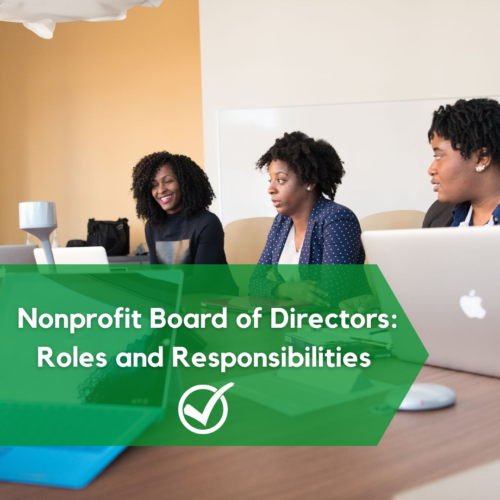What is a board of directors?
A board of directors is the leading group behind a nonprofit organization. It can have a variety of roles, but the must-haves are the president, the secretary, and the treasurer. These three will work in concert to control the nonprofit’s high-level decision making, and fill specific niches that others cannot.
The board of directors must have at least one meeting each year, with all members present. Having more meetings will ensure that all members are in alignment with the nonprofit’s current state, and keep operations running efficiently.
There are minimal regulations on who, specifically, can take on each membership role – but there are plenty of general guidelines that should ideally be followed. Skill in their specific role is necessary, but so too is passion for your nonprofit’s overall cause. If your cause primarily affects a specific demographic of people, or a few particular demographics, you should strongly consider having people of those demographics take leadership roles here. Skill is excellent and passion is phenomenal, but there is little replacement for real-world experience when it comes to making informed decisions.
How is it structured?
A well-constructed board of directors has three main roles for people to fill. They consist of a president who makes the high-level decisions, a secretary that does much of the organization needed for meetings to run smoothly, and the treasurer who handles financial tasks for the nonprofit. The coordination between them is central to the structure of the board of directors, as this task is too large for any one person to do alone.
No position within the board of directors should be permanent. Each board member will serve a term ranging from 2 to 5 years. Ideally, these terms are staggered relative to other members – it’s inadvisable to have several new members be inducted at once.
1. President

The president is the leader of the board. They will supervise all other roles, and serve as the primary contact for all board members. Most high-level decision making must pass through the president’s approval.
The president’s duties include leading performance evaluation and self-evaluation processes. They also nominate and/or approve members and leaders of any committees within the nonprofit, and can serve as the spokesperson for the nonprofit organization.
Note that this is a separate role from the nonprofit’s CEO, though both distinct roles can be served by the same individual. The main distinguishing factor is that, where the president handles high-level decisions, the CEO may be geared towards granular day-to-day operations.
2. Secretary

The secretary tracks and monitors a wide variety of information. This can be anything from the various activities of the nonprofit (and especially the board of directors itself), to recording the minutes of each meeting. The secretary is the one who will do most of the outreach, if a given member needs contacting. In meetings, the secretary is responsible for much of the documentation needed going in (if any), and will track any votes the board members make.
In addition, the secretary will also work to ensure the nonprofit’s activities align with any laws and bylaws. This would apply in the case of political lobbying, as an example.
3. Treasurer

The treasurer is in charge of anything finance-related. They will catalog any purchase receipts the nonprofit creates, track financial spending, and is the chair of the finance committee. Any bank accounts associated directly with the nonprofit will have the treasurer as a signatory.
In creating financial reports, the executive director will work closely with the treasurer to keep things up-to-date. The treasurer also has a critical role in the annual auditing process.
Why are they important?
The governance and management of a nonprofit have a lot of moving parts. While the initial development stages of these operations may allow general staff to handle both high-level and ground-level decisions, it’s generally preferable to draw a line between these decisions as the nonprofit grows.
You’ll need someone to handle the nonprofit’s vision, long-term planning, and ultimate goals. It will be up to others to bring those goals into reality. This is why the distinction between governance and management is so important – in this context, these words do not mean the same thing, and recognizing that will be key in understanding why a board of directors is so important.
Governance
Governance covers high-level decisions. Any kind of long-term strategic planning, goal-setting, and oversight will fill this niche. People who govern will guide those who manage – not the other way around. They will set the standard by which others in the organization will be evaluated. In addition, they must be willing to evaluate their own standards, and the overall state of the nonprofit, to see if their standards are reasonable.
Management
Management covers the day-to-day scope of nonprofit operations. Conducting events, face-to-face interactions, processing of donations, anything on that scale. Most activities a nonprofit takes on will happen at this scale, but each activity will follow the guidance of those who govern it.


